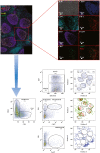How to dissect the plasticity of antigen-specific immune response: a tissue perspective
- PMID: 31626717
- PMCID: PMC6954674
- DOI: 10.1111/cei.13386
How to dissect the plasticity of antigen-specific immune response: a tissue perspective
Abstract
Generation of antigen-specific humoral responses following vaccination or infection requires the maturation and function of highly specialized immune cells in secondary lymphoid organs (SLO), such as lymph nodes or tonsils. Factors that orchestrate the dynamics of these cells are still poorly understood. Currently, experimental approaches that enable a detailed description of the function of the immune system in SLO have been mainly developed and optimized in animal models. Conversely, methodological approaches in humans are mainly based on the use of blood-associated material because of the challenging access to tissues. Indeed, only few studies in humans were able to provide a discrete description of the complex network of cytokines, chemokines and lymphocytes acting in tissues after antigenic challenge. Furthermore, even fewer data are currently available on the interaction occurring within the complex micro-architecture of the SLO. This information is crucial in order to design particular vaccination strategies, especially for patients affected by chronic and immune compromising medical conditions who are under-vaccinated or who respond poorly to immunizations. Analysis of immune cells in different human tissues by high-throughput technologies, able to obtain data ranging from gene signature to protein expression and cell phenotypes, is needed to dissect the peculiarity of each immune cell in a definite human tissue. The main aim of this review is to provide an in-depth description of the current available methodologies, proven evidence and future perspectives in the analysis of immune mechanisms following immunization or infections in SLO.
Keywords: OMICs sciences; computational immunology; cytometry; immune system; lymphocytes; microscopy.
© 2019 British Society for Immunology.
Conflict of interest statement
The authors have no conflicts of interest to declare.
Figures




References
Publication types
MeSH terms
Substances
LinkOut - more resources
Full Text Sources
Medical

